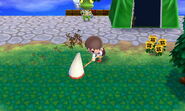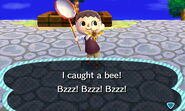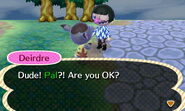- "I caught a bee! Bzzz! Bzzz! Bzzz! Phew! ...But why am I still holding it?!" —New Leaf
The bee (ハチ, Hachi?) is a "harmful" bug introduced in Animal Crossing. Though bees appear in large numbers, they can only be caught in singular form, like ants. Once a bee is caught, the other bees in the swarm will dissipate.
Bees are not visible unless shaken out of their beehives. Once the beehive falls, bees will emerge. Only five beehives are generated each day, but they cannot be found if the wireless gate is open and/or other players are inside the town. In New Leaf beehives can appear in any trees including fruit trees, whereas in previous games only regular non-fruit trees can hold them.
In New Leaf, beehives can be picked up and sold for 500 Bells.
Behavior
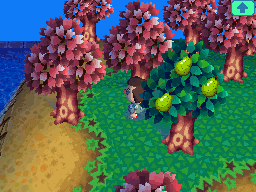
A player takes advantage of the slow turning speed of a bee to catch it.
Bees, once shaken, will continue to chase the player indefinitely until the player enters a building or quits the game. Bees follow the player and travel faster than running speed, however they are fairly slow to turn which can be used to the advantage of the player. In most games, a simple 5-second run from the tree, net equip, and net swing into the swarm is sufficient to catch them if the timing is right. In New Leaf, it is possible to hit the beehive with the net and catch the bee before they can swarm.
If the bees catch the player, the player's left eyelid will swell, and villagers will often laugh at or chide the player when they are in this stung state, with the exception of uchi villagers who give medicine to cure the stings. Sometimes other villager types will give the player medicine, such as lazy or normal villagers, who will comment on their condition (lazy villagers expressing how cool it looks) before offering medicine. Villagers will mention a swarm of bees in conversation if it is nearby, a trait shared with scorpions and tarantulas.
Donating to the museum
In Animal Crossing
Blathers will remark: "Why, I'd imagine it took more than a bit of skill and daring to catch bees! You've got 'moxie,' as I believe they say. I'm certain you must have been stung numerous times. How terribly painful that must have been, eh wot? Incidentally, do you know how some honeybees protect their hives when attacked by giant wasps? The giant wasps can't survive heats above 113 degrees, but the honeybees can live at heats up to 122 degrees. The canny honeybees use this nine-degree difference to their fullest advantage, wot! When the wasps arrive, the bees attack them en masse. A single wasp may be swarmed by up to 500 bees! Now this is truly amazing. The bees then begin to vibrate, creating a veritable cocoon of suffocating heat. Do you see the genius at work here? This swarming is but a feverish defense against the giant wasps' weakness. The temperature? Hoo hoo! Lo and behold, 120 degrees! Just below the bees own threshold of survival! In this incredible fashion, the honeybees literally lay their lives on the line to protect the hive! Stupendous! To be honest, I learned that from a wee documentary I saw on the telly! Of course, incredible feats can only go so far. When all is said and done, they're still insects, and still ghastly!"
In Wild World
Blathers will comment on the player's donation as follows:
"I once thought that its stinger was a bee's lone defense, but... ...I've recently heard that they also possess terribly repulsive breath! Of course, the gent who told me this was a bit of a rabid liar, but still! I would heartily endorse the following action if you see another: FLEE LIKE MAD! Stingers and bad breath, honestly! What monstrous little beasties..."
In City Folk
Blathers will comment on your donation as follows:
"It can be quite dangerous to receive a large dose of bee venom-- for example, by being stung. That said, did you know that same substance is actually used in some women's perfumes? Indeed! A potent venom and a potent perfume... Which do you suppose is more devastating, wot?"
The bee can be found buzzing about on the highest tier of the bug room, among the trees.
In New Leaf
In New Leaf an information board in the bug exhibit will list information about this bug.
"Bees are prone to attacking anyone who comes too close to their hive, so be careful when approaching! The yellow and black you see on their bodies are colors often used to convey danger. This danger is pretty significant, as many varieties of bees are capable of stinging multiple times."
The bee can be found flying from tree to tree along the back wall of the museum's bug exhibit. It will occasionally leave the tree and fly around for a bit before returning to its hive.
Capture quotes
- "I caught a bee! Bzzz bzz bzz bzzzzz! I'm glad it didn't sting me!" —Animal Crossing
- "I caught a bee! I'm so happy...that I didn't get stung!" —Wild World
- "I caught a bee! Bzz! Bzz! Bzz! Glad I didn't get stung!" —City Folk
- "I caught a bee! Bzzz! Bzzz! Bzzz! Phew! ...But why am I still holding it?!" —New Leaf
| When Stung |
|---|
|
| Japanese Quotes |
|---|
|
「ハチを 捕まえた! ブン! ブン! ブン! 刺されなくって よかったぁ!」 —Animal Forest e+
「ハチを つかまえた! ブン! ブン! ブン! ふ~~っ 刺されなくて 良かったぁ~!」 —New Leaf
「ハチに 刺されちゃった イテテ…」 —New Leaf
|
Encyclopedia information
Wild World
Bug
|
Encyclopedia Information
| |

|
"These dangerous bugs are black and yellow." | |
| Size | 38 mm | |
| Time | All day | |
| Season | All year | |
| Icon | ||
City Folk
Bug
|
Encyclopedia Information
| ||||||||
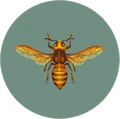
|
| ||||||||
New Leaf
Bug
|
Encyclopedia Information
| ||||||||
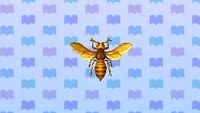
|
| ||||||||
Trivia
- In New Leaf, if there are bees in the vicinity and a player talks to a villager while they're fishing, they will only bring up the fishing dialogue instead of the bee chase restriction.
- Since bees usually appear with the beehive in New Leaf, the total would be 3,000 bells if both the bee and the beehive were included.
- Wearing something on the player's face to cover up the bee sting (i.e. glasses) will not prevent villagers from noticing it.
- There are certain circumstances when bees cannot appear. These include:
- If the gates are open in Wild World and City Folk.
- If a villager follows the player to go to their house in New Leaf.
Gallery
| Villager Reactions |
|---|
|
Tutu reacting to the player's swollen face. Talking to Groucho while bees are in the vicinity. Talking to Katt while bees are in the vicinity. Talking to Rhonda while bees are in the vicinity. Talking to Tank while bees are in the vicinity. Talking to Groucho while bees are in the vicinity. Talking to Katt while bees are in the vicinity. Talking to Colton while bees are in the vicinity. Talking to Victoria while bees are in the vicinity. Talking to Alice while bees are in the vicinity. Talking to Broffina while bees are in the vicinity. Deirdre's reaction to a stung player. Talking to Rhonda while bees are in the vicinity. Talking to Curlos while bees are in the vicinity. Talking to Katt while bees are in the vicinity. Talking to Broffina while bees are in the vicinity Talking to Alice while bees are in the vicinity. Talking to Victoria while bees are in the vicinity. |
| Videos |
|---|
Further information
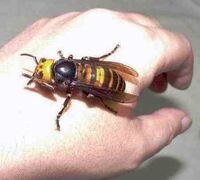
A Japanese giant hornet
- Main article: Japanese giant hornet on Wikipedia
Though they are called bees in-game, the stinging insects that appear when shaking trees are actually Japanese giant hornets. The Japanese giant hornet is the largest species of wasp in the world, and can reach a length of over 5 cm. The name "bee" in the Animal Crossing series is a mistranslation: the Japanese name はち hachi refers to both wasps and bees, though the term "bee" is also colloquially applied to wasps in English-speaking communities despite their taxonomic differences. This wasp preys on hives of honeybees: once one has located a hive, it sprays it with chemicals which attract other wasps. Together, they can destroy entire hives of thirty thousand bees or more in less than four hours. Their sting can be very dangerous, as not only are these wasps are very aggressive and sting many times, but their venom also contains a potent toxin strong enough to corrode flesh. Because of this, a sufficient amount of stings can cause serious medical complications such as renal failure. It is estimated that around 30 people die in Japan every year as a result of giant hornet stings.








